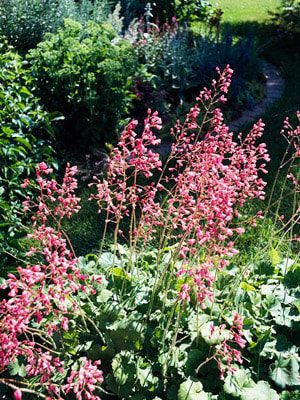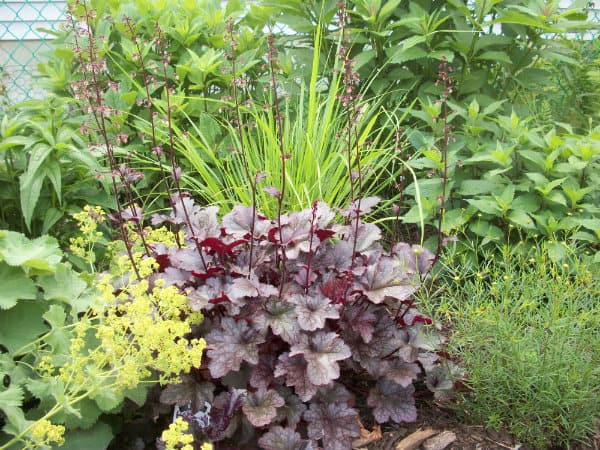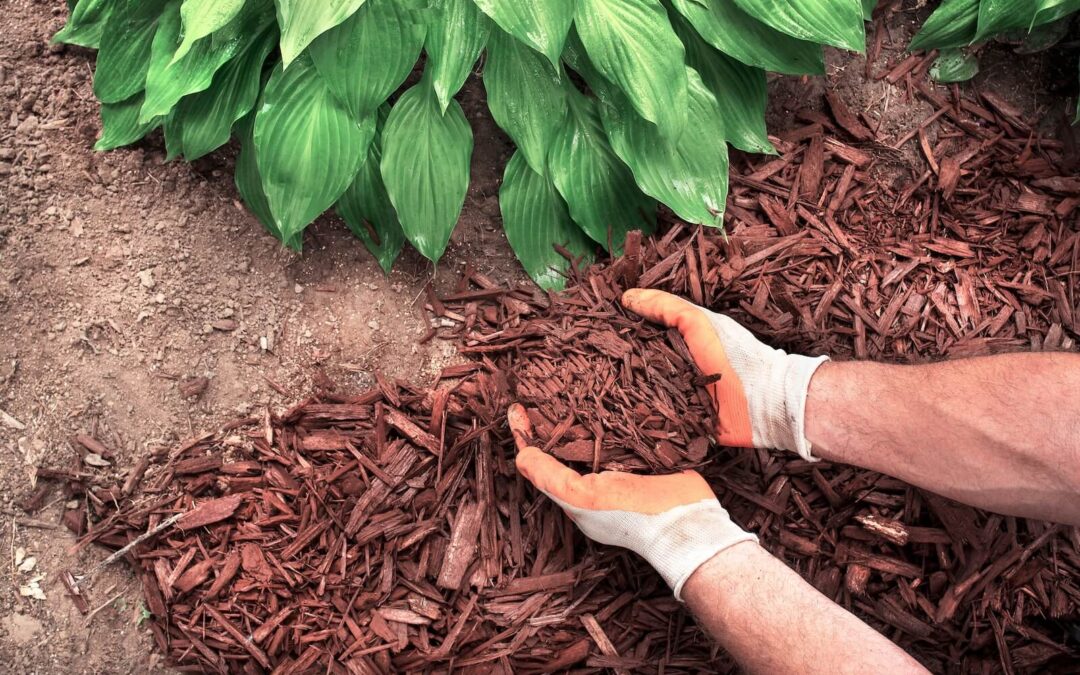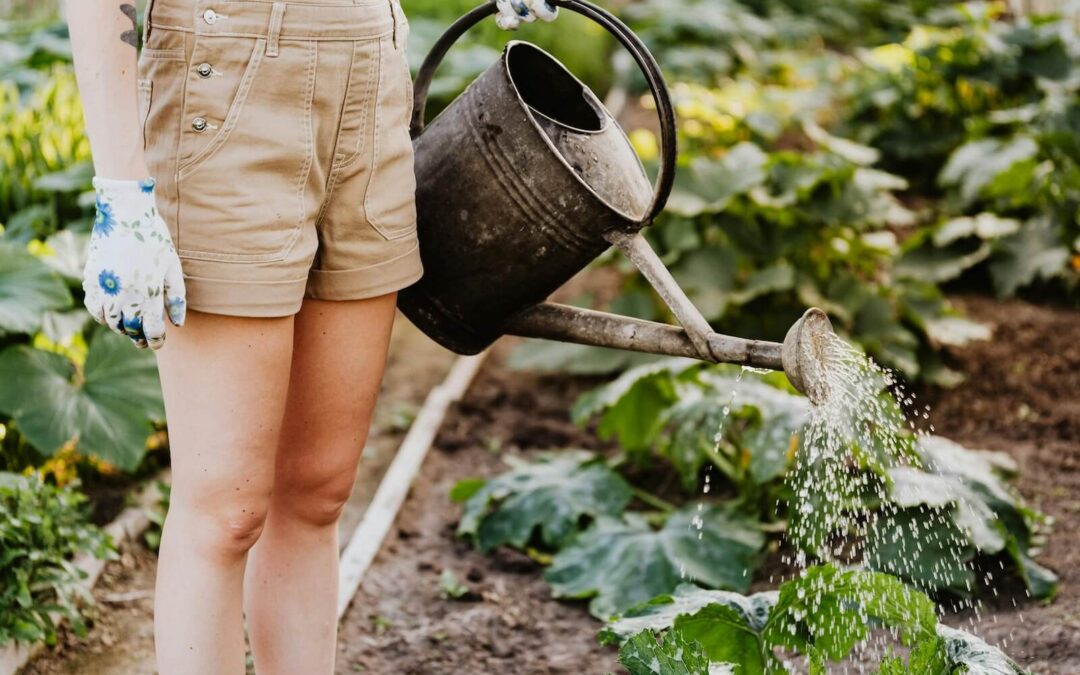Coral bells (Heuchera) are popular perennial plants that can survive and thrive in many different growing spaces and local climates. They are popular due to their hardiness (thriving in both hot and cold environments) and their wide selection of colors and varieties, ranging from white and pink, to light coral and a deeper red.
Most coral bells bloom in late spring and early summer, but there are also late-blooming types, which give you the perfect chance to add some autumn color to your yard. These perennials are a prime example of a low-maintenance Colorado native plant that can provide aesthetic appeal to garden landscapes year after year.
Coral Bells typically have tiny clouds of white, red, pink, or coral blooms that are bell-shaped, growing from a slender stalk that shoots up and above their abundant foliage. Additionally, some varieties produce creamy white flowers, adding brightness and contrast to the foliage. These plants love the sun. However, they prefer partial shade when they live in an area that’s as hot and dry as ours.
Colorado gardeners will appreciate that Heuchera plants prefer sandy and well-draining soil since we have plenty of that in the area. They can be watered sporadically during the summer and go without water for a bit after a refreshing summer storm. Heuchera ‘Forever Purple’ is particularly notable for its attractive purple leaves with dark purple veins, enhancing its visual appeal.
The elegant foliage of coral bells, with its diverse colors and textures, enhances garden designs and complements other plants beautifully.
How To Use Coral Bells
Coral bells are a beautiful family of perennials native to American soil. Their flower stalks add height and visual appeal to gardens. They bloom in hundreds of vibrant colors, and they serve as the perfect complement to any garden or landscape. Certain varieties produce long and strong flower stems suitable for cut flowers. Flowers emerge from delicate pink buds, contributing to the overall aesthetic and texture of gardens and containers. These pink flowers add ornamental value and can complement different foliage colors, attracting pollinators like bees and butterflies.
Cultivators note their extreme tolerance to drought, heat, and humidity, making the coral bells one of the most versatile species out there. They’re also resistant to most foliar diseases and pests, which means they’re generally low maintenance and don’t require extensive use of chemicals. For best results, plant coral bells in late fall or early spring, ensuring proper spacing and soil conditions. Check these plants out if you want to incorporate a sustainable landscape.
How To Grow Coral Bells
Coral bells grow fairly easily and require minimal maintenance. Like all plants and flowers, you want to imitate their natural growing conditions for optimal health and longevity, which, for these plants, is shady and wooded areas. Avoid growing them in full sun as too much sun can lead to burned or scorched leaves, especially in hot climates. Woodland plants make suitable companion plants for coral bells, creating a harmonious garden setting in shaded areas. Make sure their soil is well-drained and they receive efficient airflow. Too much moisture build-up can cause fungal infections, which is one of the most common problems when growing these plants.
Shade-Loving Coral Bells
Another advantage of implementing coral bells as part of your landscape design is that they’re a shade-tolerant plant. Their shade tolerance means they can tolerate low light levels and grow as well as other plants do in full sun.
Coral bells are shade-tolerant plants that can be planted beneath larger trees or plants to accentuate an existing landscape design. These beautiful plants are also ideal for gardens or yards with limited space as they won’t be as dependent on receiving a full day of sun.
Coral Bell Issues and Care Tips
Part of the appeal of planting coral bells is their durability. However, as hardy as these plants can be, they aren’t impervious to pests and disease. For most gardeners and homeowners, fungal infection seems to be the most apparent issue.
These infections include rust and other general fungal infections. Fungal issues tend to become more problematic in hot and humid weather—so be sure to keep an eye on these plants during the dog days of summer. If you notice a fungal infection taking hold of your coral bells, a copper fungicide may be a good resolution.
However, it’s better to prevent these infections before they begin. To ward off potential fungal infections, make sure that your coral bells have good drainage and proper airflow. If too much moisture builds up, a fungal infection is likely to follow.
Coral Bell Varieties
Coral bells come in a wide variety of colors, which means that this plant is perfect for any garden or landscaping project. Here are some of the most popular coral bell varieties:
- Watermelon Heuchera
- Green Spice
- Ginger Ale
- Georgia Peach
- Lime Marmalade
- Lime Rickey
- Melting Fire
- Midnight Rose
- Paris
- Peach Crisp
- Southern Comfort
- Red Lightning
- Sugar Plum
Many of these varieties are known for their showy blooms, which attract hummingbirds, bees, and butterflies. Additionally, yellow flowers like Rudbeckia and coneflowers can be planted alongside coral bells to enhance the visual appeal of your garden.
Quality Coral Bells in Colorado
Coral bells are a perfect addition to almost any garden or backyard landscape design. Available in a wide variety of unique colors and bold varieties, these Colorado perennials can transform any outdoor living space.
You won’t be the only one attracted to the delicate Coral Bell blooms. Bees and hummingbirds flock to them during their late spring and early summer flowering seasons.
Once the blooms have faded, you can cut back the stalks to enjoy the foliage. These plants will remain happy in their beds through the winter, and all you need to do is remove their dead foliage each spring. Every three to four years, you’ll want to divide them and transplant the divided halves.
Don’t forget that Lifescape Colorado is more than happy to take care of your garden maintenance once your landscape design and build-out is complete. Contact us today for more information about our services.





